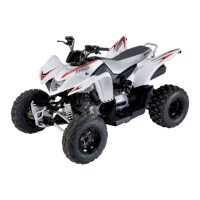ENGINE
4-26
CYLINDER WARP:
0.05 mm MAX
3. Inspect cylinder for wear, scratches, or damage.
4. Inspect cylinder for taper and out of round with a
telescoping gauge or a dial bore gauge. Measure in two
different directions, front to back and side to side, on three
different levels (10mmdown from top, in the middle, and
10mmup from bottom).
5. Record measurements. If cylinder is tapered or
beyond specification, the cylinder
replaced.
CYLINDER TAPER
Limit: 0.05mm Max.
CYLINDER OUT OF ROUND
Limit: 0.05mm Max.
CYLINDER HONE SELECTION/HONING
PROCEDURE
A hone, which will straighten as well as remove
material from the cylinder, is very important. Using a
common spring loaded glaze breaker for honing is
not advised. Polaris recommends using a rigid hone
or arbor-honing machine. Cylinders may be wet or
dry honed depending upon the hone manufacturer’s
recommendations. Wet honing removes more
material faster and leaves a more distinct pattern in
the bore.
HONING TO DEGLAZE
A finished cylinder should have a crosshatch pattern to ensure
piston ring seating and to aid in the retention of the fuel/oil
mixture during initial break in. Hone cylinder according to
hone manufacturer’s instructions, or these guidelines:
◎ Use a motor speed of approximately 300-
hone in and out of the cylinder rapidly until cutting tension
decreases. Remember to keep the hone drive shaft centered (or
cylinder centered on arbor) and to bring the stones
approximately 1.3 cm above and below the bore at the end of
each stroke.
◎ Release the hone at regular intervals
determine if it has been sufficiently deglazed, and to check for
correct cross--hatch.
NOTE: Do not allow cylinder to heat up during
honing.

